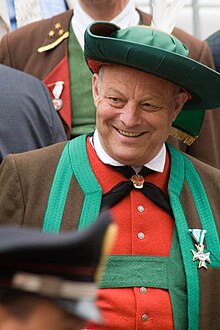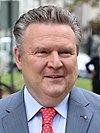Landeshauptmann

The Landeshauptmann (if male) or Landeshauptfrau (if female) (German:
Origins
Since the
With the dissolution of
Austria
In modern Austria, the title is used for the head of the executive of the nine Austrian states, equivalent to the position of a Ministerpräsident in German states. In English speaking countries, the title is usually translated as "governor," though as mentioned above the function corresponds more to that of minister-president or premier.
The Landeshauptmann is elected by the Landtag (state parliament) of the respective state and sworn in by the President of Austria. In practice, the landeshauptmann is almost always the leader of the majority party in the Landtag, or the leader of the senior partner in the governing coalition. As representative of the federal government on state level, the landeshauptmann is also responsible for the enforcement of federal laws. Unlike in the federal government, there is no distinction between the head of state and head of government and the landeshauptmann serves both roles.
As
List of governors
South Tyrol and Trentino
According to the 1946 Gruber–De Gasperi Agreement and the Second Autonomy Statute of 1972, the chief executives of the provincial governments (Italian: Presidente della Provincia autonoma) of South Tyrol and Trentino are called Landeshauptleute in German.
The head of
Despite the German terms Landeshauptmann and Landtag, South Tyrol and Trentino according to Italian conception are no federated states (Länder) but merely subnational administrative divisions (enti territoriali), though with considerable self-government responsibilities and legislative powers.
| Portrait | Name | Region | Took office | Political party
| |
|---|---|---|---|---|---|

|
Arno Kompatscher | See also: List of governors of South Tyrol |
9 January 2014 | South Tyrolean People's Party | |

|
Maurizio Fugatti | See also: List of presidents of Trentino |
22 October 2018 | Northern League |
Prussia
From 1875 the territorial authority of the estates in the twelve administrative provinces of Prussia were re-organised as Provinzialverbände. Each of these self-governing bodies were represented in a Provinziallandtag assembly, whose members were delegated by the rural and urban districts within the province. The districts organised through their elected deputies their utilities, such as construction and maintenance of provincial roads, hospitals, schools, public savings banks, waste disposal etc., in self-rule.
The provincial administration was initially headed by a Landesdirektor, who was elected by the assembly for six-year terms (in Pomerania: five years) and maximally two terms. The holder of the office presided over the Provinzialausschuss, i.e. provincial government of self-rule, whereas the Oberpräsident was the king-appointed representative for the province, busy with implementing and supervising central prerogatives of the Prussian government.
In the following decades, Landeshauptmann gradually replaced the earlier expression Landesdirektor in all but one of Prussia's provinces. When the kingdom turned into a
Klaipėda Region
The









